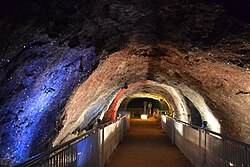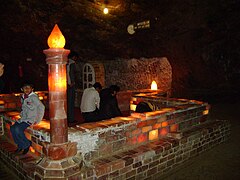
Khewra Salt Mine

 Khewra Salt Mine tunnel (Crystal Valley) | |
| Location | |
|---|---|
| Location | Khewra |
| Province | |
| Country | |
| Coordinates | 32°38′52.58″N 73°00′30.22″E / 32.6479389°N 73.0083944°E |
| Production | |
| Products | Rock salt |
| Production | 3,50,000 MT |
| Financial year | 2019–20 |
| History | |
| Opened | 1872 |
| Active | 150 years |
| Owner | |
| Company | Pakistan Mineral Development Corporation |
| Website | www.PMDC.gov.pk |
The Khewra Salt Mine (Urdu: کھیوڑہ نمک کان), also known as Mayo Salt Mine, is the world's second largest salt mine, located in Khewra, Punjab, Pakistan.[1] The mine is in the Salt Range of the Potohar plateau, which rises from the Indus plain of the Punjab.[2] [3][4][5][6]

The mine is famous for its production of pink Khewra salt, often marketed as Himalayan salt, and is a major tourist attraction, drawing up to 250,000 visitors a year.[7] Its history dates back to its discovery by Alexander's troops in 326 BC, but it started trading in the Mughal era.[8] The main tunnel at ground level was developed by H. Warth, a mining engineer, in 1872 during British rule. After independence, the BMR took possession until 1956 and then PIDC owned the mines till 1965. After India-Pakistan war in 1965, the WPIDC took over the administration of salt mines and in 1974, the Pakistan Mineral Development Corporation took over the mine, which still remains the largest source of salt in the country, producing more than 350,000 tons per annum[9] of about 99% pure halite.[7] Estimates of the reserves of salt in the mine vary from 82 million tons[10] to 600 million tons.[11]

Geology
The Khewra Salt Mine is excavated within the base of a thick layer of highly folded, faulted, and stretched Ediacaran to early Cambrian evaporites of the Salt Range Formation. This geological formation consists of a basal layer of crystalline halite, which is intercalated with potash salts. This basal layer is overlain by gypsiferous marl, which is covered by interlayered beds of gypsum and dolomite with infrequent seams of oil shale. These strata are overlain by 200 to 500 meters (660 to 1,640 ft) of Neoproterozoic to Eocene sedimentary rocks that have been uplifted and eroded along with the Salt Range Formation to create the Salt Range at the southern edge of the Pothohar Plateau. The Ediacaran to early Cambrian evaporites of the Salt Range Formation have been thrust southward over Neoproterozoic to Eocene sedimentary rocks by many kilometers, which tectonically incorporated fragments of the underlying younger strata within these evaporites. The Salt Range is the southern edge of a well-described fold-and-thrust belt, which underlies the entire Pothohar Plateau and developed south of the Himalayas as a result of the ongoing collision between India and Eurasia.[12][13][14]

Palynomorphs (organic microfossils) have been used to make inferences about the ages of the Salt Range Formation and its salt layers that are exposed within the Khewra Salt Mine. For example, while working with Geological Survey of India in the 1930s and 1940s, Birbal Sahni reported finding evidence of angiosperms, gymnosperms, and insects inside the mine which he regarded as originating from the Eocene period.[15] However, on the basis of additional geologic data, later research has concluded that these palynomorphs were contaminants.[16][17][18]

History

The Khewra Salt Mine is also known as Mayo Salt Mine, in honour of Lord Mayo, who visited it as Viceroy of India.[19] The salt reserves at Khewra were discovered when Alexander the Great crossed the Jhelum and Mianwali region during his Indian campaign. The mine was discovered, however, not by Alexander, nor by his allies, but by his army's horses, when they were found licking the stones.[20] Ailing horses of his army also recovered after licking the rock salt stones.[21] During the Mughal era the salt was traded in various markets, as far away as Central Asia.[22] On the downfall of the Mughal empire, the mine was taken over by Sikhs. Hari Singh Nalwa, the Sikh Commander-in-Chief, shared the management of the Salt Range with Gulab Singh, the Raja of Jammu. The former controlled the Warcha mine, while the latter held Khewra. The salt quarried during Sikh rule was both eaten and used as a source of revenue.[citation needed]

In 1872, some time after they had taken over the Sikhs' territory, the British developed the mine further.[8] They found the mining to have been inefficient, with irregular and narrow tunnels and entrances that made the movement of labourers difficult and dangerous. The supply of water inside the mine was poor, and there was no storage facility for the mined salt. The only road to the mine was over difficult, rocky terrain. To address these problems the government levelled the road, built warehouses, provided a water supply, improved the entrances and tunnels, and introduced a better mechanism for excavation of salt. Penalties were introduced to control salt smuggling.[23]

Location

Khewra Salt Mine is in Pind Dadan Khan Tehsil of Jhelum District. About 160 km (99 mi) from Islamabad and Lahore, it is accessed via the M-2 Motorway, about 30 kilometres (19 miles) off the Lilla interchange while going towards Pind Dadan Khan on the Lilla road.[24][25] The mine is in mountains that are part of a salt range, a mineral-rich mountain system extending about 200 km from the Jhelum River south of Pothohar Plateau to the Indus River near Kalabagh.[6][8][26] Khewra mine is about 288 meters (945 feet) above sea level[27] and about 730 meters (2,400 feet) into the mountain from the mine entrance. The underground mine covers an area of 110 km2 (42 sq mi).[citation needed]

Production

Estimates of the total reserves of salt in the mines range from 82 million tons[which?][10] to over 600 million tons.[11] In raw form it contains negligible amounts of Calcium, Magnesium, Potassium sulfates, and moisture; it also contains iron, zinc, copper, manganese, chromium, and lead as trace elements.[28][29] Salt from Khewra, also known as Khewra salt, is red, pink, off-white or transparent.[30] In the early years of British rule, the Khewra mine produced about 28,000 to 30,000 tons per annum; it increased to about 187,400 tons per annum for the five fiscal years ending 1946–47 and to 136,824 tons for the two years ending 1949–50 with the systematic working introduced by H. Warth.[31] The mine's output was reported in 2003 to be 385,000 tons of salt per annum, which amounts to almost half of Pakistan's total production of rock salt.[32] At that rate of output, the tunnel would be expected to last for another 350 years.[9]

The mine comprises nineteen stories, of which eleven are below ground. From the entrance, the mine extends about 730 meters (2,400 feet) into the mountains, and the total length of its tunnels is about 40 km (25 mi).[4][33] Quarrying is done using the room and pillar method, mining only half of the salt and leaving the remaining half to support what is above.[34] The temperature inside the mine remains about 18–20 °C (64–68 °F) throughout the year.[21] The 2 ft (610 mm) narrow gauge Khewra Salt Mines Railway track laid during the British era is used to bring salt out of the mine in rail cars.[35]

Khewra salt is Pakistan's best known rock salt.[11] It is used for cooking, as bath salt, as brine[30] and as a raw material for many industries, including a soda ash plant set up by AkzoNobel in 1940.[36] Salt from Khewra mine is also used to make decorative items like lamps, vases, ashtrays and statues,[37] which are exported to the United States, India and many European countries.[35][38] The use of rock salt to make artistic and decorative items started during the Mughal era, when many craftsman made tableware and decorations from it.[39] Warth introduced the use of a lathe to cut out art pieces from the rock salt, as he found it similar to gypsum in physical characteristics.[40]

In 2008 the Government of Pakistan decided to sell off seventeen profitable organisations including Khewra salt mines,[41] but the plan was shelved. The mine is now operated by the Pakistan Mineral Development Corporation, a government department.[33]

Tourism

Khewra Salt Mine is a major tourist attraction, with around 250,000 visitors a year,[7] earning it considerable revenue.[27] Visitors are taken into the mine on the Khewra Salt Mines Railway.[21] There are numerous pools of salty water inside. The Badshahi Masjid was built in the mining tunnels with multi-coloured salt bricks[8][42] about fifty years ago.[25] Other artistic carvings in the mine include a replica of Minar-e-Pakistan, a statue of Allama Iqbal, an accumulation of crystals that forms the name of Muhammad in Urdu script, a model of the Great Wall of China and another of the Mall Road of Murree.[21][25] In 2003 two phases of development of tourist facilities and attractions were carried out, at a total cost of 9 million rupees. A clinical ward with 20 beds was established in 2007, costing 10 million rupees,[43] for the treatment of asthma and other respiratory diseases using salt therapy.[44] The "Visit Pakistan Year 2007" event included a train safari visit of Khewra Salt Mine.[45] In February 2011 Pakistan Railways started operating special trains for tourists from Lahore and Rawalpindi to Khewra. For this purpose the railway station of Khewra was refurbished with the help of a private firm.[46]

Other visitor attractions in the mine include the 75-meter-high (245-foot-high) Assembly Hall; Pul-Saraat, a salt bridge with no pillars over a 25-meter-deep (80-foot-deep) brine pond; Sheesh Mahal (Palace of Mirrors), where salt crystals are light pink; and a café.[24][25]

-
A mosque has been built inside the salt mines.
-
Rock salt makes for some beautiful texture on the walls and ceiling.
-
It is said that these rooms were mined during the Mughal era.
-
Reflection in salty water at Khewra Salt Mines.
-
Crystal Valley, a tunnel with crystals in the wall and roof, illuminated by colourful lights.
-
Artistic work with rock salt.
-
Copy of Minaar-e-Pakistan made of rock salt.
-
Walls made of rock salt.
Other projects

The Pakistan Mineral Development Corporation established the Mine Survey Institute at Khewra in 1971.[7] The institute conducts mine surveys, organises mining-related courses for the miners[47] and established the Khewra Model High School and the Khewra Women College.[7][47] More recently the miners won an important environmental case against the mining company for the provision of unpolluted drinking water.[48] The water available to the residents of Khewra had been polluted by salt, coal and other nearby mining activity. This case is internationally recognised as important with regard to the relationship between humanity and the environment.[49][50][51]

In 2003, while the Government of Pakistan was looking for ways to increase the country's strategic store of oil to 90 days, the PMDC put forward a proposal to use the Khewra mines to store strategic oil reserves.[27] Scientific reports confirmed the feasibility of this proposal, but it was turned down.[52]

Flooding in 2010
In 2010, during torrential rain all over Pakistan, water from a nearby nullah entered the mine,[53] reaching a depth of two feet (61 cm) and blocking the exits, after which the mine was closed.[54] It was subsequently reopened and remains open.[55]

References
- ^ O.H.K. Spate; Andrew T.A. Learmonth; B.H. Farmer (13 July 1972). India, Pakistan and Ceylon: The Regions. Methuen Publishing Ltd. p. 502. ISBN 978-0-416-75530-5. Retrieved 3 April 2012.
- ^ Weller, J. Marvyn (1928). "The Cenozoic History of the Northwest Punjab". The Journal of Geology. 36 (4). Chicago Journals: 362–375. doi:10.1086/623522. JSTOR 30055696. S2CID 129105623.
- ^ Stanley J. Lefond (1 January 1969). Handbook of World Salt Resources (1st ed.). Springer. p. 347. ISBN 978-0-306-30315-9. Retrieved 3 April 2012.
- ^ a b Camerapix (July 1998). Spectrum Guide to Pakistan. Interlink Books. p. 150. ISBN 978-1-56656-240-9. Retrieved 8 April 2012.
- ^ Masud ul Hasan (1975). Short encyclopaedia of Pakistan (1st ed.). Ferozsons. p. 118. ASIN B007EU8QHS. Retrieved 8 April 2012.
- ^ a b Pete Heiden (August 2011). Pakistan. Essential Library. p. 27. ISBN 978-1-61783-117-1. Retrieved 14 April 2012.
- ^ a b c d e "Khewra Salt Mines Project". Pakistan Mineral Development Corporation. Privatisation Commission of Pakistan. Archived from the original on 25 July 2012. Retrieved 12 April 2012.
- ^ a b c d Sarina Singh; Lindsay Brown; Lindsay Brown; Rodney Cocks; John Mock (1 May 2008). Lonely Planet Pakistan and the Karakoram Highway (7th ed.). Lonely Planet. p. 138. ISBN 978-1-74104-542-0. Retrieved 3 April 2012.
- ^ a b Pennington, Matthew (25 January 2005). "Pakistan salt mined old-fashioned way mine". The Seattle Times. Archived from the original on 25 July 2012. Retrieved 8 April 2012.
- ^ a b Natural Resources of Humid Tropical Asia (Natural Resources Research) (1st ed.). UNESCO. April 1974. p. 101. ISBN 978-92-3-101056-9. Retrieved 14 May 2012.
- ^ a b c Frank C. Whitmore; Mary Ellen Williams (1982). Resources for the twenty-first century. Washington D.C.: U.S. Geological Survey. p. 175. OCLC 623259129. Retrieved 7 April 2012.
- ^ Jaumé, S.C. and Lillie, R.J., 1988. Mechanics of the Salt Range‐Potwar Plateau, Pakistan: A fold‐and‐thrust belt underlain by evaporites. Tectonics, 7(1), pp.57-71.
- ^ Grelaud, S., Sassi, W., de Lamotte, D.F., Jaswal, T. and Roure, F., 2002. Kinematics of eastern Salt Range and South Potwar basin (Pakistan): a new scenario. Marine and Petroleum Geology, 19(9), pp.1127-1139.
- ^ Richards, L., King, R.C., Collins, A.S., Sayab, M., Khan, M.A., Haneef, M., Morley, C.K. and Warren, J., 2015. Macrostructures vs microstructures in evaporite detachments: An example from the Salt Range, Pakistan. Journal of Asian Earth Sciences, 113, pp.922-934.
- ^ SAHNI, B.; TRIVEDI, B. S. (1945). "Age of the Saline Series in the Salt Range of the Punjab". Nature. 155 (3925): 76–77. doi:10.1038/155076b0. ISSN 0028-0836. S2CID 4092748.
- ^ Schindewolf, O.H. and Seilacher, A., 1955. Beiträge zur Kenntnis des Kambriums in der Salt Range (Pakistan): Akademie der Wissenschaften und der Literatur, Mainz Mathematisch-Naturwissenschaflichen Klasse Abhandlungen, 10, pp.261-446.
- ^ Teichert, C., 1964. Recent German work on the Cambria and Saline Series of the Salt Range: West Pakistan: Pakistan Geological Survey Records, 11, no. 1, pp. 1–2.
- ^ Hughes, N.C., 2017. Biostratigraphical dating conundrums in the Cambrian and earlier stratigraphy of the Indian subcontinent: The Palaeobotanist, 66, pp. 1–15.
- ^ Society of Arts (Great Britain) (7 November 2011). Journal of the Society of Arts. Vol. 43. Nabu Press. p. 258. ISBN 978-1-271-48500-0. Retrieved 15 April 2012.
- ^ Karen Zarindast (Reporter) (8 November 2011). Pakistan salt mine is open to tourists in the Punjab province (News report). BBC. Retrieved 14 May 2012.
- ^ a b c d Faisal Khan, Zeeshan (12 December 2010). "Khewra: Above the salt". Dawn. Retrieved 13 April 2012.
- ^ Andre Wink (March 1990). Al Hind: The Making of the Indo Islamic World. Brill Academic Publishers. p. 171. ISBN 978-90-04-09249-5. Retrieved 7 April 2012.
- ^ Sir Edwin Arnold (1862). The Marquis of Dalhousie's Administration of British India. Vol. 1. Saunders, Otley, and Co. p. 166. ISBN 978-1-290-28762-3. Retrieved 7 April 2012.
- ^ a b F. I. Dar; Safdar Vail (22 December 2005). "The beauty of Khewra Salt Range". Dawn. Archived from the original on 21 January 2013. Retrieved 14 April 2012.
- ^ a b c d Sheikh, FD (12 April 2008). "Khewra Salt Mines: A fascinating place". Dawn. Archived from the original on 21 January 2013. Retrieved 13 April 2012.
- ^ Stacy Taus-Bolstad (January 2003). Pakistan in Pictures. Lerner Publishing Group. p. 55. ISBN 978-0-8225-4682-5. Retrieved 14 April 2012.
- ^ a b c "PMDC offers salt mine for oil reserves". Dawn. 28 February 2003. Retrieved 13 April 2012.
- ^ Robert V. Titler; Paul Curry (14 September 2011). Chemical Analysis of major constituents and trace contaminants of Rock Salt (PDF) (Technical report). Pennsylvania Department of Environmental Protection. p. 17. Archived from the original (PDF) on 19 January 2012. Retrieved 15 April 2012.
- ^ Qazi Muhammad Sharif; Mumtaz Hussain; Muhammad Tahir Hussain (December 2007). Viqar Uddin Ahmad; Muhammad Raza Shah (eds.). "Chemical Evaluation of Major Salt Deposits of Pakistan" (PDF). Journal of the Chemical Society of Pakistan. 29 (26). Chemical Society of Pakistan: 570–571. Retrieved 15 April 2012.
- ^ a b Dorothy K. Moore. "The Significance of Salt" (PDF). Eugene: Material Science Institute, University of Oregon. p. 33. Archived from the original on 1 March 2015. Retrieved 8 April 2012.
{{cite web}}: CS1 maint: bot: original URL status unknown (link) - ^ J.Coggin Brown (7 February 2008). Mineral Wealth: Part III. Materials used in building construction, civil engineering, etc. Isha Books. p. 507. ISBN 978-81-8205-483-7. Retrieved 5 April 2012.
- ^ Kogan Page (1 August 2003). Asia & Pacific Review 2003/04 (21st ed.). World of Information. p. 279. ISBN 978-0-7494-4063-3. Retrieved 8 April 2012.
- ^ a b "Khewra Salt mine". Salt mine. Pakistan Mineral Development Corporation. Archived from the original on 26 March 2012. Retrieved 7 April 2012.
- ^ Bushra Khalid. "Effect of Temperature and Humidity on Salt Mine Environment" (PDF). Pakistan Journal of Meteorology. 7 (13). Pakistan Meteorological Department: 73. Retrieved 8 April 2012.
- ^ a b Helen Bateman; Jayne Denshire (30 July 2005). Dangerous Creatures of the Oceans. Creative Co. p. 9. ISBN 978-1-58340-768-4. Retrieved 3 April 2012.
- ^ A. K. Madan (1949). The economic prospects of chemical industries in India. Thacker. p. 119. ASIN B007HDU8LY. Retrieved 13 April 2012.
- ^ "Salt production target on track this year". Daily Times. Associated Press of Pakistan. 12 November 2003. Archived from the original on 5 November 2004. Retrieved 8 April 2012.
- ^ "PMDC to increase salt exports". Dawn. 29 December 2004. Retrieved 14 April 2012.
- ^ Annemarie Schimmel (5 February 2004). The Empire of the Great Mughals: History, Art and Culture. Reaktion Books. p. 102. ISBN 978-1-86189-185-3. Retrieved 15 April 2012.
- ^ James Joseph Louis Ratton (30 August 2011). Hand-book of Common Salt. Nabu Press. pp. 10–11. ISBN 978-1-178-95413-5. Retrieved 15 April 2012.
- ^ "Steel Mills to be sold this fiscal". The Nation. 14 November 2008. Archived from the original on 7 January 2009. Retrieved 12 April 2012.
- ^ Annemarie Schimmel (December 1980). Islam in the Indian Subcontinent. Brill Academic Publishers. p. 107. ISBN 978-90-04-06117-0. Retrieved 7 April 2012.
- ^ "Salt mine resort for asthma patients". Dawn. 27 March 2007. Retrieved 14 April 2012.
- ^ Shahzad, Khurram (26 March 2010). "Asthma treatment in Pakistani salt mine". The Telegraph. Retrieved 6 April 2012.
- ^ "Prepare to 'visit Pakistan Year 2007'". Daily Times. 8 December 2006. Archived from the original on 16 April 2013. Retrieved 13 April 2012.
- ^ "Khewra railway station restored". Dawn. 5 February 2011. Retrieved 12 April 2012.
- ^ a b "Mine Survey Institute". Khewra Services. PMDC. Archived from the original on 12 April 2012. Retrieved 12 April 2012.
- ^ General Secretary, West Pakistan Salt Miners Labor Union Khewra, Jhelum v. The Director, Industries and Mineral Development, Punjab, Lahora, Human Rights Case No. 120 of 1993, (1994) S.C.M.R. at 2061.
- ^ "Pakistan – Constitutional Rights, Mining Operations, Water Pollution". UNESCAP Virtual Conference. United Nations. 30 October 2003. Archived from the original on 7 June 2011. Retrieved 8 April 2012.
- ^ http://www.unhchr.ch/environment/bp4.html UNHCR paper on Human Rights and the environment
- ^ Louis J Kotzé; A. Paterson (16 April 2009). The Role of Judiciary in Environmental Governance: Comparative Perspectives. Wolters Kluwer Law & Business. pp. 396–397. ISBN 978-90-411-2708-2. Retrieved 15 April 2012.
- ^ "Building oil reserves with taxpayers' money". Dawn. 27 November 2006. Retrieved 14 April 2012.
- ^ "Floodwaters enter Khewra Salt Mines". The Nation. 7 August 2010. Archived from the original on 5 October 2013. Retrieved 12 April 2012.
- ^ "Breach floods 10 villages". The Express Tribune. 12 August 2012. Retrieved 14 April 2012.
- ^ "Khewra salt mines: Healing heights". 14 October 2013.
External links
- Khewra Salt Mines – Pakistan Mineral Development Corporation
See what we do next...
OR
By submitting your email or phone number, you're giving mschf permission to send you email and/or recurring marketing texts. Data rates may apply. Text stop to cancel, help for help.
Success: You're subscribed now !










